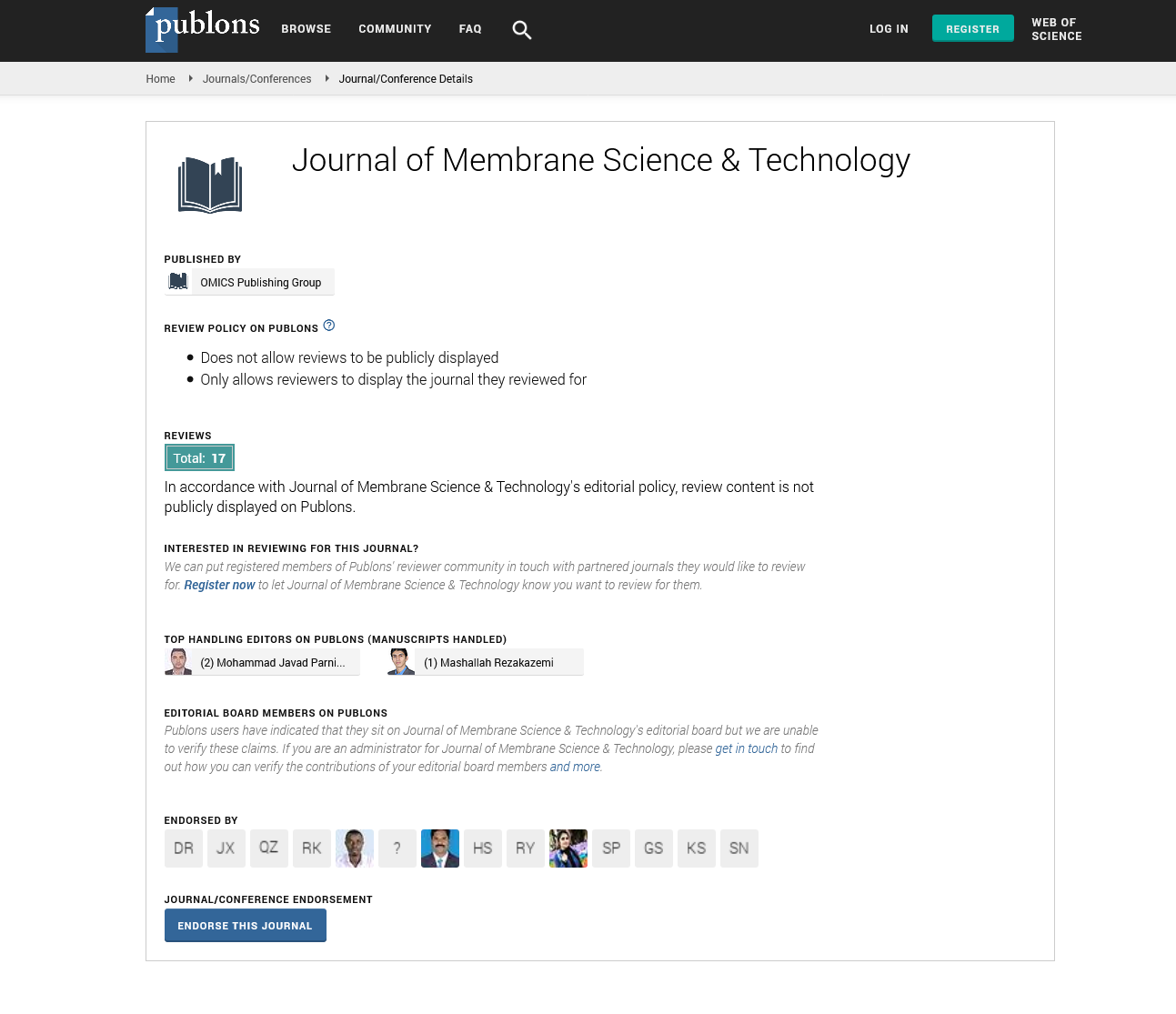Indexed In
- Open J Gate
- Genamics JournalSeek
- Ulrich's Periodicals Directory
- RefSeek
- Directory of Research Journal Indexing (DRJI)
- Hamdard University
- EBSCO A-Z
- OCLC- WorldCat
- Proquest Summons
- Scholarsteer
- Publons
- Geneva Foundation for Medical Education and Research
- Euro Pub
- Google Scholar
Useful Links
Share This Page
Journal Flyer

Open Access Journals
- Agri and Aquaculture
- Biochemistry
- Bioinformatics & Systems Biology
- Business & Management
- Chemistry
- Clinical Sciences
- Engineering
- Food & Nutrition
- General Science
- Genetics & Molecular Biology
- Immunology & Microbiology
- Medical Sciences
- Neuroscience & Psychology
- Nursing & Health Care
- Pharmaceutical Sciences
Short Communication - (2024) Volume 14, Issue 4
The Role of Cholesterol in Membrane Fluidity and Stability
Muhammad Ahmed*Received: 29-Nov-2024, Manuscript No. JMST-24-28382; Editor assigned: 02-Dec-2024, Pre QC No. JMST-24-28382 (PQ); Reviewed: 16-Dec-2024, QC No. JMST-24-28382; Revised: 23-Dec-2024, Manuscript No. JMST-24-28382 (R); Published: 30-Dec-2024, DOI: 10.35248/2155-9589.24.14.408
Description
Cholesterol is a necessity component of the plasma membrane in eukaryotic cells, playing a critical role in regulating membrane fluidity and stability. Its unique structure, consisting of a rigid steroid ring system, a hydrophilic hydroxyl group and a hydrophobic hydrocarbon tail, enables cholesterol to interact with the phospholipids in the membrane [1,2]. This interaction is vital for maintaining the membrane's structural integrity and its ability to adapt to various environmental conditions.
The fluidity of a cell membrane refers to the ease with which lipids and proteins move within the bilayer. This property is important for membrane functions, including diffusion, endocytosis, exocytosis and the functioning of membrane proteins. Cholesterol modulates membrane fluidity by inserting itself between phospholipid molecules [3,4]. Its rigid steroid ring interacts with the fatty acid chains of phospholipids, reducing their movement and thereby decreasing membrane fluidity in regions that might otherwise become overly fluid.
Interestingly, cholesterol exhibits a dual effect on fluidity. In regions where the membrane is composed predominantly of saturated fatty acids, which tend to pack tightly, cholesterol increases fluidity by disrupting the orderly arrangement of the fatty acid chains [5,6]. Conversely, in regions rich in unsaturated fatty acids, which are more loosely packed due to kinks in their hydrocarbon chains, cholesterol reduces fluidity by filling in the gaps. This bidirectional regulation ensures that the membrane remains in an optimal fluid state, neither too rigid nor too fluid.
Cholesterol also contributes to membrane stability by reducing permeability and preventing the bilayer from becoming overly fragile. The presence of cholesterol in the membrane reduces the ability of small, water-soluble molecules to pass through, thereby maintaining the selective permeability necessity for cellular homeostasis [7,8]. By interacting with both saturated and unsaturated fatty acids, cholesterol enhances the overall cohesiveness of the bilayer, making it more resistant to mechanical stress and temperature fluctuations.
In cold environments, cholesterol prevents the membrane from becoming too rigid by disrupting the tight packing of phospholipids, ensuring the membrane remains functional. In contrast, at high temperatures, cholesterol restrains the movement of phospholipids, preventing the membrane from becoming excessively fluid and losing its structural integrity [9]. This temperature-buffering role of cholesterol is particularly important in maintaining the functionality of cells exposed to varying environmental conditions.
Lipid rafts are microdomains within the membrane that are enriched in cholesterol, sphingolipids and specific proteins. These regions are more ordered and less fluid than the surrounding membrane. Cholesterol plays a key role in the formation and maintenance of lipid rafts, stabilizing the interactions between sphingolipids and proteins. These microdomains are important for cellular processes such as signal transduction, protein trafficking and pathogen entry.
Imbalances in cholesterol levels can lead to various pathological conditions. Excess cholesterol in the membrane can result in decreased fluidity, impairing membrane protein function and promoting the formation of rigid structures that contribute to conditions such as atherosclerosis [10]. Conversely, a deficiency in cholesterol can compromise membrane integrity, leading to increased permeability and vulnerability to damage.
In neurodegenerative diseases like Alzheimer’s, altered cholesterol metabolism affects membrane composition and fluidity, influencing the processing of Amyloid Precursor Protein (APP) and the formation of amyloid-beta plaques. Understanding the role of cholesterol in membrane effictives could provide insights into therapeutic strategies for such diseases.
References
- Presti FT. The role of cholesterol in regulating membrane fluidity. Mem fluidity. 1985;4:97-145.
- Yamaguchi T, Ishimatu T. Effects of cholesterol on membrane stability of human erythrocytes. Biol Pharm Bull. 2020;43(10):1604-1608.
[Crossref] [Google Scholar] [PubMed]
- Naito M. Effects of cholesterol and cholesterol esters on cell function I. incorporation of free cholesterol and cholesterol oleate into the cell membrane and its effects on membrane fluidity, membrane fragility and dna synthesis. Cell Str Fun. 1978;3(3):219-226.
- Konings AW, Ruifrok AC. Role of membrane lipids and membrane fluidity in thermosensitivity and thermotolerance of mammalian cells. Radiat Res. 1985;102(1):86-98.
[Crossref] [Google Scholar] [PubMed]
- Krause MR, Regen SL. The structural role of cholesterol in cell membranes: from condensed bilayers to lipid rafts. Acc Chem Res. 2014;47(12):3512-3521.
[Crossref] [Google Scholar] [PubMed]
- Sułkowski WW, Pentak D, Nowak K, Sułkowska A. The influence of temperature, cholesterol content and pH on liposome stability. Jour of mol str. 2005;744:737-747.
- Jovanović AA, Balanč BD, Ota A, Ahlin Grabnar P, Djordjević VB, Šavikin KP,et al. Comparative effects of cholesterol and β‐sitosterol on the liposome membrane characteristics. Eur Jour of Lip Sci Tech. 2018;120(9):1800039.
- Kaddah S, Khreich N, Kaddah F, Charcosset C, Greige-Gerges H. Cholesterol modulates the liposome membrane fluidity and permeability for a hydrophilic molecule. Food Chem Toxicol. 2018;113:40-48.
[Crossref] [Google Scholar] [PubMed]
- Papahadjopoulos D. Cholesterol and cell membrane function: a hypothesis concerning the etiology of atherosclerosis. J Theor Biol. 1974;43(2):329-337.
[Crossref] [Google Scholar] [PubMed]
- Feinstein MB, Fernandez SM, Sha'Afi RI. Fluidity of natural membranes and phosphatidylserine and ganglioside dispersions: Effects of local anesthetics, cholesterol and protein. Biochim Biophys Acta. 1975;413(3):354-370.
[Crossref] [Google Scholar] [PubMed]
Citation: Ahmed M (2024). The Role of Cholesterol in Membrane Fluidity and Stability. J Membr Sci Technol. 14:408.
Copyright: © 2024 Ahmed M. This is an open-access article distributed under the terms of the Creative Commons Attribution License, which permits unrestricted use, distribution, and reproduction in any medium, provided the original author and source are credited.

